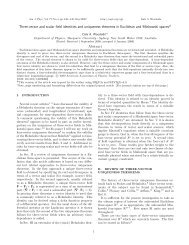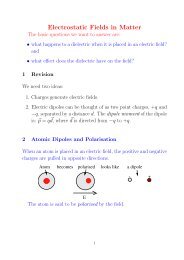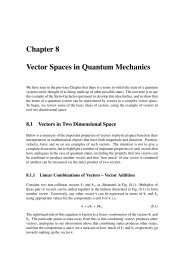AOS News - The Australian Optical Society - Macquarie University
AOS News - The Australian Optical Society - Macquarie University
AOS News - The Australian Optical Society - Macquarie University
- No tags were found...
You also want an ePaper? Increase the reach of your titles
YUMPU automatically turns print PDFs into web optimized ePapers that Google loves.
<strong>AOS</strong> <strong>News</strong> Volume 25 Number 1 2011Quantum opticsan <strong>Australian</strong> perspectiveby Hans-A. BachorQuantum optics is a very active research field in Australia and across theglobe. This article traces some of the history how we got into such a strongposition and shows some of the opportunities ahead.Quantum optics encompasses any systemthat makes use of the quantum natureof light, from the generation of light, inparticular with lasers, to its detection andthe interaction with matter. Nowadays thefocus is very much on sensing applicationsand metrology below the limit imposed byquantum noise and the communicationand processing of quantum information,which is in itself a very new field ofscience. Quantum optics is now enteringthe era of practical applications andcommercialization, with the leadingpractical example being quantum keydistribution [1].In parallel we have developed the abilityto use coherent matter waves in very similarways to coherent light. We now have atomlasers and atom interferometers, we useand build more accurate atomic clocksthat have coherent atomic oscillatorsand we can record the quantum statisticsof atoms in a similar way to photons.Here the breakthrough was the coolingof atoms to ultra-cold temperatures,approaching nano Kelvin, and the BoseEinstein Condensate, as a new state ofmatter. Recently we created and begin tounderstand comparable coherent effectsin Fermions. Furthermore several groupsare also looking at electronic circuits andmechanical systems at the quantum noiselimit. Quantum technology can now bediscussed with confidence [2].Australia is extremely active andsuccessful in all of these topics, it has nowa large number of active research groups,excellent support through several ARCCentres of Excellence (COE) in the firstand second generation, and an outstandinginternational reputation. Around theworld our colleagues are astounded ofour creativity in producing a noticeablefraction of all the publications and thisfield. All of these set the foundationsof future quantum technologies whereAustralia is capable of playing a significantrole. Similarly, <strong>Australian</strong> studies ofresearch quality and research output showquantum science as one of the highlights[3].A bit of historyThis has not always been the case -the field is young and in our country itexpanded rapidly. In the mid 1980s thefield was still dominated by theory. <strong>The</strong>major questions were: what is impact ofnonlinearities on quantum propertiesof light and can we modify the photonstatistics? <strong>The</strong>re was a competition forthe first generation of nonclassical,or squeezed, continuous light, almostexclusively in the US. Entangled singlephotons had been demonstrated throughthe famous Bell experiments in Francebut the interference of single photonswas still an experiment for the future.<strong>The</strong> focus at that time was to understandand demonstrate these quantum effects,to develop new techniques and findnew materials that could create therequired nonlinear response, to measurequantum statistics, and confirm theorypredictions.Under the leadership of Dan Wallsand Crispin Gardiner, New Zealandhad become a hub for quantum optics,while conventional laser technologywas very active in Australia at ANU,<strong>Macquarie</strong> and Auckland and similarlyconventional spectroscopy includingCSIRO, Peter Hannaford, the <strong>University</strong>of Melbourne, Tony Opat, ANU JohnSandemans and Peter Fisk, and Otgao<strong>University</strong> with Jack Dodd. <strong>The</strong> famousQuantum Optics summer schools [4]had become a Mecca for young scientistfrom this region, allowing us to meetleading research from across the globe.Dan Walls created an outstanding schoolfor theoretical quantum optics, whichgenerated several generations of successfulscientist, including Gerard Milburn,Craig savage, Howard Carmichael, PeterDrummond and Margaret Reid, whoform now a major backbone of the currentresearch field.By this stage the team led by HansBachor at ANU focused on experimentalprojects, complementary to the strongtheory activity in NZ. Building on theFigure 1. <strong>The</strong> Dan Walls summer school 1986. Front row from left includes: DavidPegg, Carlton Caves, Marlin Skully, Carlo Tombesi, Dan Walls, Gerard Milburn(behind Dan), Mark Levenson, John Harvey. <strong>The</strong> author is: 2nd row from back 4thfrom left.13
















